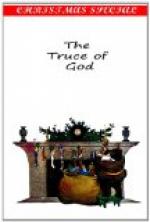“I will accompany you,” said the duke, “if you will delay your departure a few minutes.”
Father Omehr expressed his assent, and retired to the chapel with Herman, leaving the two knights in close converse. Gilbert ran to order the best horse for the duke, and to see that his venerable benefactor should want nothing to carry him safely over the intervening hills. After exchanging many kind adieus, Rodolph and the missionary, near the close of twilight, started for the Castle of Stramen.
CHAPTER IV
_...Simonis leprosam Execrate haeresim, Sacerdotum simul atque Scelus adulterii, Laicorum dominatus Cedat ab ecclesiis._
ST. PETER DAMIAN.
The King of Arles and the missionary rode along without an escort, and felt none of the fears that the traveller of the times is often made to entertain for his personal safety. They did not apprehend any violence, and their only preparation for the expedition had been a recommendation to God through Our Lady and the Saints. It is as purely imaginative in historians and novelists—and it is difficult indeed to distinguish the one from the other—to surround every castle with a wall of banditti, as to station in Catholic countries of the present day, a robber or an assassin behind every tree. In the Middle Ages, the stranger could wander from castle to castle with as little danger as the nature of the country permitted; even in times of war, the blind, the young, the sick, and the clergy were privileged from outrage, though found on hostile territory. And in war, peace, or truce, the pilgrim’s shallop was a passport through Christendom; he was under the special protection of the Pope, and to thwart his pious designs was to incur excommunication. Even amid the terrors of invasion, the laborer was free to pursue his occupation, and his flocks and his herds were secure from molestation; for it was beneath the dignity of the man-at-arms to trample upon the person or property of the poor unarmed peasant. Such were the principles recognized even in the eleventh century; and though we witness frequent departures from these admirable provisions, we must be careful not to mistake the exception for the rule, or to impute to the spirit of the age a violence and contempt of authority common to all times, and found alike in Norman and Frank, American and Mexican. To balance these infringements of regular warfare or “blessed peace,” we often meet with instances as beautiful as the march of Duke Louis, the husband of St. Elizabeth, into Franconia, in 1225, to obtain reparation for injuries inflicted on a peddler.
“I hope the Baron of Stramen has lost none of his vigor,” said the duke; “we were together at Hohenburg, and I may need him at my side again. His son Henry, too, whom I knighted before the battle, and who won his spurs so nobly, how is he?”
“They were both well,” replied Father Omehr, “when I saw them last, and were anxiously expecting a visit from their liege.”




